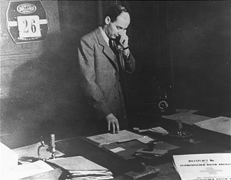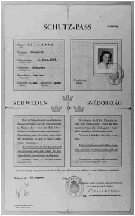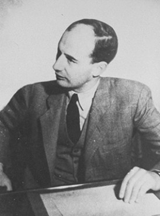 |










Raoul Wallenberg, 32 years old, left his home and wealthy family in Stockholm, Sweden in 1944 on a mission financed by the United States to save Jews from the Nazis in Budapest, Hungary. The Russians kidnapped him in January, 1945 and held Wallenberg for decades in Russian prisons.
Jim Magid
Amherst College

Buy The Book
|
About Raoul Wallenberg
 Raoul Wallenberg (1912-?) was one of the great heroes of World War II and one of the first victims of the Cold War. In 1944, as a Swedish diplomat in Budapest, he saved tens of thousands of Hungarian Jews from certain death. Taken into custody by the Russians at the beginning of 1945, he simply disappeared. Raoul Wallenberg (1912-?) was one of the great heroes of World War II and one of the first victims of the Cold War. In 1944, as a Swedish diplomat in Budapest, he saved tens of thousands of Hungarian Jews from certain death. Taken into custody by the Russians at the beginning of 1945, he simply disappeared.
Raoul Wallenberg was born on August 4, 1912, into one of Sweden's wealthiest families, three months after his father had died of cancer. His grandfather, a distinguished diplomat, saw to it that the precocious boy traveled and studied widely, acquiring fluency in several languages, international perspective, and savoir-faire.
After graduation in 1935 from the University of Michigan with an honors baccalaureate in architecture, Wallenberg worked in commercial enterprises first in Capetown and then in Haifa, where he learned from German refugees what was happening to the Jewish Germans under Hitler. In 1941 he joined a Stockholm-based export firm whose Jewish owner could no longer safely travel in Hitler-controlled Central Europe. In this position he developed a knowledge of Budapest that made him an ideal volunteer three years later for a desperate rescue mission initiated by the U.S. War Refugee Board.
Until the last year of the war, Hungary, though an Axis ally, had not cooperated in Hitler's program of genocide. Its Jewish community, once Europe's third largest, had even been increased by Jews seeking refuge in Hungary. In 1944, however, German army units moved in, together with a special SS force commanded by SS-Lt. Col. Adolf Eichmann, the engineer of the Holocaust. During the spring and summer of 1944 his men scoured the Hungarian countryside, rounding up and sending 400,000 Jews and others to the death camps.
Read Excerpts from Raoul Wallenberg's Personal Diary
 Determined to do whatever he could to save the 200,000 surviving Jews assembled in Budapest, Wallenberg accepted a diplomatic appointment to the Swedish legation as special attaché for humanitarian questions. Carrying the two knapsacks he had used hitchhiking in America, a sleeping bag, a windbreaker, and a revolver, the soft-spoken, dark-eyed bachelor of 31 arrived in Budapest in July 1944 with a mandate even more unusual for a diplomat than his baggage: he had elicited from the Swedish Foreign Ministry, with American support, formal personal authorization to appeal directly to Stockholm, to use his unprecedented funding (from U.S. and Jewish sources) even for bribery, and to grant Swedish diplomatic asylum to documented victims of persecution. Determined to do whatever he could to save the 200,000 surviving Jews assembled in Budapest, Wallenberg accepted a diplomatic appointment to the Swedish legation as special attaché for humanitarian questions. Carrying the two knapsacks he had used hitchhiking in America, a sleeping bag, a windbreaker, and a revolver, the soft-spoken, dark-eyed bachelor of 31 arrived in Budapest in July 1944 with a mandate even more unusual for a diplomat than his baggage: he had elicited from the Swedish Foreign Ministry, with American support, formal personal authorization to appeal directly to Stockholm, to use his unprecedented funding (from U.S. and Jewish sources) even for bribery, and to grant Swedish diplomatic asylum to documented victims of persecution.
He opened a special branch office of the Swedish legation near the Jewish quarter, built up a staff of 400 (mostly Jews, all granted diplomatic immunity), and by January 1945, when the Russians took Budapest, had issued protective passports to perhaps 20,000 Jews placing them under the protection of the Swedish crown until they could emigrate to Sweden. He sheltered over 12,000 in dozens of buildings over which he flew the Swedish colors, making them de facto annexes of the Swedish legation with extra-territorial status.
To the consternation of bureaucratic colleagues, Wallenberg acted on the premise that the conventional rules could not be honored. "When there is suffering without limits, there can be no limits to the methods one should use to alleviate it," he argued and, with desperate ingenuity, acted accordingly. He cajoled, intimidated, and bribed Axis officials, established networks of spies within the Hungarian fascist party and the Budapest police, provided officials with food and amenities from hoards he could afford to lay in before the black market was sold out, and even issued protective passes to key fascists—documents that might greatly facilitate their "disappearance" at the end of the war.
 His authority with the Hungarians established, Wallenberg fearlessly challenged the Germans, going so far as to retrieve intended victims from the trains on which they had been jammed for shipment to Auschwitz and personally to confront Eichmann, who was behind at least one attempt on his life. His approach was vigorously followed by representatives of other neutrals, particularly the Swiss consul Charles Lutz, who not only provided documentation to thousands of Jews but accompanied Wallenberg in the perilous retrieval of Auschwitz-bound victims. His authority with the Hungarians established, Wallenberg fearlessly challenged the Germans, going so far as to retrieve intended victims from the trains on which they had been jammed for shipment to Auschwitz and personally to confront Eichmann, who was behind at least one attempt on his life. His approach was vigorously followed by representatives of other neutrals, particularly the Swiss consul Charles Lutz, who not only provided documentation to thousands of Jews but accompanied Wallenberg in the perilous retrieval of Auschwitz-bound victims.
In the final days of his mission, as the Russians closed in on the surrounded city, fanatically anti-Semitic Hungarian fascist death squads sought to finish what Eichmann, who had withdrawn in December 1944, had left undone. Countless Jews saved from Auschwitz were murdered in the streets or drowned in the Danube. But Wallenberg's network of collaborators thwarted the fascist murderers' plans for a last-minute, full-scale massacre of the 100,000 Jews who had survived in Budapest.
When the city fell to the Soviet Army in January 1945, Wallenberg was taken into custody by the Russians— possibly as an American agent or possibly because of his fascist connections (realistically cultivated to fulfill his mission). That spring, he did not return to Sweden with the other members of the Budapest legation staff who were held for six weeks after their "liberation" in a Soviet internment camp. The Swedish government then enquired about Wallenberg.
In 1947 Soviet Deputy Foreign Minister Andrei Vyshinsky finally came up with an answer: Wallenberg was not in the Soviet Union and was assumed to have died during the struggle for Budapest. Not until 1957, after Stockholm had begun to pursue the matter seriously, did Moscow acknowledge responsibility and formally expressed regrets. Deputy Foreign Minister Andrei Gromyko informed the Swedish ambassador that Wallenberg had died of heart failure in prison in 1947 and had been cremated. But numerous reports indicated that Wallenberg was moved with deliberate frequency from one location to another and was alive in captivity, possibly as late as 1981.
By the end of the 1970s an international movement on behalf of Wallenberg, including participation by many he had saved, organized support for his release to the United States, at whose behest he had undertaken his mission to Hungary. In October 1981 Wallenberg was proclaimed an honorary citizen of the United States—a distinction previously accorded only the descendants of the Marquis de Lafayette and Sir Winston Churchill. The law granting him honorary citizenship also provided, belatedly if not posthumously, for "all possible steps [to be taken] … to secure his return to freedom."
Russian President Boris Yeltsin created a special commission in 1991 to study the Wallenberg case. The commission was short-lived and failed to shed any new light on the Wallenberg mystery. Through the efforts of a number of Holocaust survivors, now American citizens, a bust honoring Wallenberg was placed in the U.S. Capitol Rotunda in 1995. The U.S. Postal Service issued a stamp (1996) in honor of the Swedish diplomat. Because of the popular belief that Wallenberg may still be alive, the Postal Service did not issue the stamp as a "commemorative," which would have implied that Wallenberg was dead. U.S. government documents released from the Central Intelligence Agency (CIA) in 1996 confirmed that Wallenberg had been a valued agent for the Office of Strategic Services (precursor to the CIA). Why the Soviets would have executed Wallenberg or have held him in captivity for so long remains unknown.
from Encyclopedia of World Biography | 2004 | COPYRIGHT 2004 The Gale Group Inc.
|
|